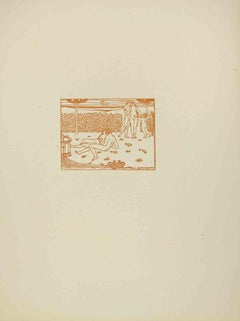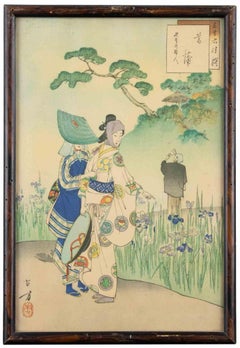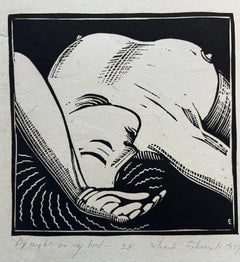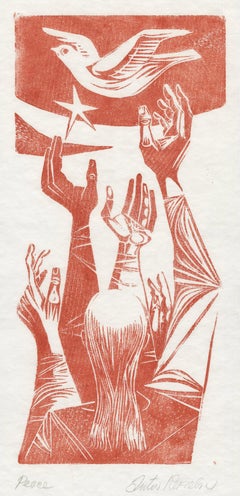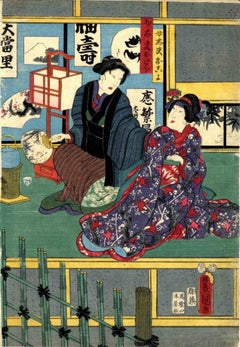Woodcut Figurative Prints
to
517
1,720
98
38
6
4
Overall Width
to
Overall Height
to
1,866
255
202
181
81
39
23
20
19
16
1
110
29
26
15
11
6
537
1,309
14
13
20
102
154
58
84
61
41
27
13
5
1,325
511
29
1,078
580
422
364
331
321
305
240
233
196
176
175
138
119
118
84
70
69
64
54
7,370
4,741
1,866
1,189
516
62
1,450
784
185
Style: Modern
Medium: Woodcut
Bathing - Woodcut by Aristide Maillol - Early 20th Century
Located in Roma, IT
Bathing is a print realized by Aristide Maillol in the early 20th Century.
Woodcut on paper.
Good conditions.
Aristide Maillol, (born December 8, 1861, Banyuls-sur-Mer, France—die...
Category
Early 20th Century Modern Woodcut Figurative Prints
Materials
Woodcut
Sanjûroku Kasen ... - Woodcut by Mizuno Toshikata - 1893
Located in Roma, IT
Nishiki-e (woodcut print), in vertical oban format (31x20.5) realized by Mizuno Toshikata in 1893 (Meiji 26).
Belongs to the Series "Sanjûroku Kasen" (Thirty-Six Beauties in Compari...
Category
1890s Modern Woodcut Figurative Prints
Materials
Woodcut
By Night On My Bed
Located in New York, NY
Woodcut. Signed by the artist and dated in pencil, lower right. Titled in pencil, lower left, and numbered "28" in pencil, lower center.
This woodcut was made by Esherick to ill...
Category
1920s American Modern Woodcut Figurative Prints
Materials
Woodcut
Peace
Located in Fairlawn, OH
Peace
Woodcut printed in orange red ink on japanese paper
Signed and titled in pencil lower right (see photo)
Titled lower left (see photo)
Created along with an illustrated book project Song of Peace, 1950-1959.
Condition: Excellent
Image: 10 1/2 x 4 7/8"
Sheet: 16 1/8 x 7";
Anton Refregier (March 20, 1905 – October 10, 1979) was a painter and muralist active in Works Progress Administration Federal Art Project commissions, and in teaching art. He was a Russian immigrant to the United States.
Among his best-known works is his mural series The History of San Francisco, located in the Rincon Center in downtown San Francisco, California. It depicts the city's history across twenty seven panels that he painted from 1940 to 1948.
Life and early career
Refregier was born in Moscow and emigrated to the United States in 1920. After working various odd jobs in New York City, he earned a scholarship to the Rhode Island School of Design in 1921. After finishing school, Refregier moved back to New York in 1925. To earn a living, Refregier worked for interior decorators, creating replicas of François Boucher and Jean-Honoré Fragonard paintings...
Category
1950s American Modern Woodcut Figurative Prints
Materials
Woodcut
Yakushae - Woodcut Print by Utagawa Kunisada - 1856
Located in Roma, IT
Yakushae is an original modern artwork realized by Utagawa Kunisada in 1856.
Woodcut print Oban from a tryptich.
An elderly lady has a worried conversation with a pretty young woma...
Category
19th Century Modern Woodcut Figurative Prints
Materials
Woodcut
Mythology : Grape Harvest with Faun and Centaur - Original wooodcut, Handsigned
Located in Paris, IDF
Honoré BROUTELLE (1866-1929)
Mythology : Grape Harvest with Faun and Centaur, 1921
Original woodcut
Handsigned in pencil
Numbered /125
On vellum 32.5 x 25.5 cm (c. 13 x 10 in)
Bears...
Category
1920s Modern Woodcut Figurative Prints
Materials
Woodcut
EARLY JACOULET - A DOWNPOUR AT METALANIM PONOPE EAST CAROLINAS
Located in Santa Monica, CA
EARLY JACOULET
PAUL JACOULET (1896 – 1960)
UNE AVERSEA METALANIM, PONAPE , EST CAROLINES, 1935
A DOWNPOUR AT METALANIM PONOPE EAT CAROLINAS (Miles 29)
Color woodcut, with metallic ...
Category
1930s Modern Woodcut Figurative Prints
Materials
Color, Woodcut
'Run Little Chillun' also 'Revival' — African American Subject
Located in Myrtle Beach, SC
Isac Friedlander, 'Run Little Chillun' also 'Revival', wood engraving, 1933, edition 50. Signed, titled and annotated 'New York 1933' in pencil. A sup...
Category
1930s American Modern Woodcut Figurative Prints
Materials
Woodcut
The Lovely Discussion - Woodcut by Mathilde Hérouard - 1920s
Located in Roma, IT
Woodcut print realized by Mathilde Hérouard in the 1920s.
Mounted on paper.
Signed in the plate.
Very good condition.
Category
1920s Modern Woodcut Figurative Prints
Materials
Woodcut
Allegory of Spring - Original wooodcut, Handsigned & Numbered
Located in Paris, IDF
MORIN-JEAN (1877-1940)
Allegory of Spring, 1923
Original woodcut
Handsigned in pencil
Numbered /125
On vellum 32.5 x 25.5 cm (c. 13 x 10 in)
Bears the blind stamp of the editor 'Ima...
Category
1920s Modern Woodcut Figurative Prints
Materials
Woodcut
Watering Can - Woodcut by Maurits Cornelis Escher - 1931
Located in Roma, IT
Woodcut print realized by Escher for the series "Emblemata", and published in 1931.
On Hollande van Gelder paper.
Edition of 300.
Unsigned, as issued. Excellent condition, matted....
Category
1930s Modern Woodcut Figurative Prints
Materials
Woodcut
Sculptor at Work - Woodcut after Takakane Fujiwara - 1950s
Located in Roma, IT
Sculptor at work is an artwork realized in the Early 20th Century after Takakane Fujiwara.
Sheet dimensions: 30 x 19.5 cm.
Reprint.
Good conditions.
Category
1950s Modern Woodcut Figurative Prints
Materials
Paper, Woodcut
Bijinga - Woodcut by Utagawa Toyohiro - Early 19th Century
Located in Roma, IT
Bijinga (New year festivities) is an original modern artwork realized by Utagawa Toyohiro in the Early 19th Century.
Woodcut Print Oban Format
New year festivities, two elegant la...
Category
19th Century Modern Woodcut Figurative Prints
Materials
Paper, Woodcut
Beehive - Woodcut by Maurits Cornelis Escher - 1931
Located in Roma, IT
Woodcut print realized by Escher for the series "Emblemata", and published in 1931.
On Hollande van Gelder paper.
Edition of 300.
Unsigned, as issued. Excellent condition, matted....
Category
1930s Modern Woodcut Figurative Prints
Materials
Woodcut
Composition (Arntz 148-175; Hagenbach A 25; Bolliger 54), Dreams and Projects
By Jean Arp
Located in Southampton, NY
Woodcut on vélin d’Arches paper. Inscription: Unsigned and unnumbered, as issued. Good condition. Notes: From the folio, Jean Arp, Dreams and Projects, 1951-1952. Published by Curt V...
Category
1950s Modern Woodcut Figurative Prints
Materials
Woodcut
$5,996 Sale Price
20% Off
Bijinga - Woodcut by Utagawa Kunisada - 1830s
Located in Roma, IT
Bijinga is an original artwork realized in 1833-1835 by Utagawa Kunisada (1786-1865).
Chuban. From the series "Tokaido gojusan tsugi no uchi" (The 53 Tokaido Stations). Courtesan i...
Category
1830s Modern Woodcut Figurative Prints
Materials
Woodcut
Portrait de Jules Renard - Woodcut by Paul Emile Colin - Early 20th Century
Located in Roma, IT
Woodcut print realized by Paul Emile Colin in the early 20th Century.
Beautiful proof of 2nd state, in only 2 copies.
Edition 1/2.
Hand signed and numbered in pencil.
Category
Early 20th Century Modern Woodcut Figurative Prints
Materials
Woodcut
Flying Demons - Woodcut by Maurits Cornelis Escher - 1932
Located in Roma, IT
Woodcut print from the Series "Der vreeselijke avonturen vas Scholastica" (The Terrible Adventures of Scholastica).
Edition of 300, published by A. J. van Dishoeck.
Unsigned, ass i...
Category
1930s Modern Woodcut Figurative Prints
Materials
Woodcut
Kabuki - Woodcut by Utagawa Kunisada II - 1840
Located in Roma, IT
Kabuki is an original artwork realized in 1864 by Utagawa Kunisada II (1823 1880).
Scene at night in a snowy forest, the actor Ichikawa Kodanji in the ro...
Category
1850s Modern Woodcut Figurative Prints
Materials
Woodcut
Actor in Onnagata Role - Woodcut Print by Utagawa Kuniyoshi - 1850s
Located in Roma, IT
Actor in onnagata role accompanied by a kamuro is an original artwork realized in the 1850s by Utagawa Kuniyoshi (January 1, 1798– April 14, 1861).
Woodcut Print.
Sign.: Ichiyusai ...
Category
1850s Modern Woodcut Figurative Prints
Materials
Woodcut
Bijinga - Woodcut by Utagawa Kunisada - 1844
Located in Roma, IT
Bijinga is an original artwork realized in the half of the 19th Century by Utagawa Kunisada (1786-1865).
From the series "SHyakunin isshu esho" (Girl's pictures and 100 poets' card...
Category
1840s Modern Woodcut Figurative Prints
Materials
Woodcut
Wedding Party
Located in Buffalo, NY
An original mid century modern woodblock print.
This work is hand signed illegibly and titled "Wedding Party".
Category
1960s Modern Woodcut Figurative Prints
Materials
Paper, Woodcut
$400 Sale Price
38% Off
Still Life - Woodcut Print by Domenico Cantatore - Mid-20th Century
Located in Roma, IT
Still Life is a contemporary artwork realized by Domenico Cantatore in the mid-20th Century.
Mixed colored woodcut print. Edition 52/75.
Hand signed by the artist on the lower marg...
Category
Mid-20th Century Modern Woodcut Figurative Prints
Materials
Woodcut
Kabuki Actor - Woodcut by Utagawa Kunisada - 1848/49
Located in Roma, IT
Kabuki Actor is a woodcut print realized by Utagawa Kunisada in 1848/49.
Lifetime impression in very good condition, except for some very minor sign of time.
Category
1840s Modern Woodcut Figurative Prints
Materials
Woodcut
Teruta-hime - Woodcut by Utagawa Kuniyoshi - 1842/43
Located in Roma, IT
Teruta-hime is a woodcut print realized by Utagawa Kuniyoshi in 1842/43.
Lifetime impression of chuban tate-e, it depicts Teruta-hime carrying a bucket of water through the snow, wi...
Category
Mid-19th Century Modern Woodcut Figurative Prints
Materials
Woodcut
Genji in the Twelve Months - Woodcut by Utagawa Toyokuni III - 1858
Located in Roma, IT
Genji in the Twelve Months / The Tenth Month (Moto) is a tryptich woodcut print realized by Utagawa Toyokuni III in 1858.
Very good condition except for some minor signs of wear.
Category
1850s Modern Woodcut Figurative Prints
Materials
Woodcut
Polo Players - Woodcut - Mid 20th century
Located in Roma, IT
Polo Players is a print realized by an anonymous in the mid-20th century.
Woodcut print on paper.
Good conditions.
Category
Mid-20th Century Modern Woodcut Figurative Prints
Materials
Woodcut
Courtesan - Woodcut by Keisai Eisen - 1830
By Keisai Eisen
Located in Roma, IT
Courtesan is an original modern artwork realized by Keisai Eisen in the first half of the 19th Century.
Signed and inscribed on plate.
Total dimension...
Category
1830s Modern Woodcut Figurative Prints
Materials
Paper, Woodcut
Sundial - Woodcut by Maurits Cornelis Escher - 1931
Located in Roma, IT
Woodcut print realized by Escher for the series "Emblemata", and published in 1931.
On Hollande van Gelder paper.
Edition of 300.
Unsigned, as issued. Excellent condition, matted....
Category
1930s Modern Woodcut Figurative Prints
Materials
Woodcut
Tengmalm's Owl - Woodcut Print by Alexander Francis Lydon - 1870
Located in Roma, IT
Tengmalm's Owl is a modern artwork realized in 1870 by the British artist Alexander Francis Lydon (1836-1917).
Woodcut print on ivory-colored paper.
Hand-colored, published by Lond...
Category
1870s Modern Woodcut Figurative Prints
Materials
Woodcut
The Virgin - Woodcut after Albrecht Durer - Early 20th Century
Located in Roma, IT
The Virgin and the Child is an original Woodcut on cream-colored paper. realized after Albrecht Durer, a reproduction of the early 20th Century from the...
Category
Early 20th Century Modern Woodcut Figurative Prints
Materials
Woodcut
Taira no Munekiyo Captures -Woodcut Print by Utagawa Hirosada - 1856
Located in Roma, IT
Taira no Munekiyo Captures Tokiwa no Mae is an original modern artwork realized by Utagawa Hirosada (Japanese, active 1825–75) in 1856.
Woodcut print oban format. Signature Ichiyosa...
Category
19th Century Modern Woodcut Figurative Prints
Materials
Woodcut
Kabukie - Woodcut by Utagawa Kuniyoshi - 1850
Located in Roma, IT
Kabukie is an original modern artwork realized by Utagawa Kuniyoshi (1798 – 1861) in the half of the 19th Century.
Original woodcut from the series...
Category
1850s Modern Woodcut Figurative Prints
Materials
Paper, Woodcut
Magic Hour, Autumn
By John DePol
Located in Myrtle Beach, SC
John DePol, 'Magic Hour, Autumn', chiaroscuro wood engraving, 1981, edition 160 in 1983. Signed, dated and titled in pencil. Signed in the block, lower right. A superb impression, on...
Category
Mid-20th Century American Modern Woodcut Figurative Prints
Materials
Woodcut
The Actor Nakamura Shikan - Woodcut by Utagawa Kunisada - Mid 19th century
Located in Roma, IT
The actor Nakamura Shikan, color woodcut, probably from the series "9 Dances", Mid-19th Century, realized by Utagawa Kunisada (1786-1865).
Dimensions. 38x26.5cm, unframed, mounted...
Category
Mid-19th Century Modern Woodcut Figurative Prints
Materials
Woodcut
Quartet No. 1
By Eugene Larkin
Located in Kansas City, MO
Eugene Larkin
Quartet No. 1
Woodcut in two colors
Signed and titled by hand
Size: 20 x 29.5 inches
COA provided
Eugene Larkin (1921-2010)
The late Eugene Larkin was an artist who worked in the Twin Cities area for many years and needs little introduction. His works have been shown, collected and appreciated by numerous galleries, museums and collectors throughout the United States.
Larkin was influential both as an artist and as a teacher. He taught at the Minneapolis College of Art and Design between 1954 and 1969, where he was head of printmaking and Chairman of the Division of Fine Arts. From 1969-1991 he was a professor in the Design Department at the University of Minnesota.
Eugene Larkin, a lithographer, teacher and artist who left behind scores of works, some of them in the permanent collections of the Library of Congress and the Museum of Modern Art. He was considered an early promoter of lithography education, Larkin introduced it into arts programs while teaching at the Minneapolis College of Art and Design and the University of Minnesota. He held a prominent place in the art world through decades of working and teaching in Minneapolis. His work depicted a wide range of subjects, from musicians to nature, including a series of woodcuts based on William Blake's ""Songs of Innocence and Experience."
Larkin also wrote a textbook, ""Design: The Search for Unity."" It was his work with lithography, an 18th-century printmaking process, for which he was best known.
His last local exhibit was a retrospective at The University of Minnesota Weisman Museum in 2005. ""Sometimes I start the artistic process from a literary source - Adam and Eve, the Egyptian nature gods, or classical Greek themes but sometimes I start from nature. Trees have always been a favorite subject. I see trees as people, as vertical objects...
Category
15th Century and Earlier Modern Woodcut Figurative Prints
Materials
Woodcut
Max Weber, Figure
By Max Weber
Located in New York, NY
One of America's great modernist innovators, Max Weber carved Figure, 1919-20, on the end piece of a wooden cigar box. This Cubist image is composed o...
Category
Early 20th Century Modern Woodcut Figurative Prints
Materials
Woodcut
Ex-Libris - Amici del Libro - woodcut - Mid 20th Century
Located in Roma, IT
Ex-Libris - Amici del Libro is an Artwork realized in Mid 20th Century.
Woodcut on paper. Hand signed in pencil.
Good conditions.
The artwork represents a minimalistic, clean desi...
Category
Mid-20th Century Modern Woodcut Figurative Prints
Materials
Woodcut
$114 Sale Price
35% Off
No Footprints Show, Where the Flowers Grow Deep
Located in Fairlawn, OH
No Footprints Show, Where the Flowers Grow Deep
Woodcut, 1961
Unsigned (as isssued)
From: The "Way" of the Woodcut, three woodcuts, 1961
Publisher: Pratt Adlib Press, Brooklyn, New Y...
Category
1960s Modern Woodcut Figurative Prints
Materials
Woodcut
Portrait of Jules Lenard - Woodcut by Paul Emile Colin - 1930 ca.
Located in Roma, IT
Woodcut print realized by Paul Emile Colin in the 1930s.
Edition of 30/35.
Hand signed and numbered.
Very good condition.
Category
1930s Modern Woodcut Figurative Prints
Materials
ABS, Woodcut
Meeting in Akashi - Woodcut Print by Utagawa Kunisada II - 1864
Located in Roma, IT
Meeting in Akashi is an original modern artwork realized by Utagawa Kunisada II and Hiroshige II in 1864.
Woodcut Print Oban Format.
From the series "Omo...
Category
19th Century Modern Woodcut Figurative Prints
Materials
Woodcut
Yakushae Aizurie - Woodcut Print by Utagawa Kuniyoshi - 1840s
Located in Roma, IT
Yakushae Aizurie is an original artwork realized in 1840-1843 by Utagawa Kuniyoshi (January 1, 1798– April 14, 1861).
Woodcut Print.
Actor in the r...
Category
1850s Modern Woodcut Figurative Prints
Materials
Woodcut
Portrait - Original Woodcut by Sergio Sergi - Early 20th Century
Located in Roma, IT
Portrait is an Original Woodcut Print on paper realized by Sergio Sergi in the Early 20th Century
Good Conditions.
The artwork is depicted through strong strokes in well-balanced c...
Category
Early 20th Century Modern Woodcut Figurative Prints
Materials
Woodcut
Portrait of Nakamura Fukus - Woodcut Print by Utagawa Kunisada - 1850s
Located in Roma, IT
Portrait of the actor Nakamura Fukusuke I is an original modern artwork realized by Utagawa Kunisada in 1858.
Woodcut print Oban Format from a tryptich.
Portrait of the actor Nakam...
Category
19th Century Modern Woodcut Figurative Prints
Materials
Woodcut
Yamabayashi Fusahachi - Woodcut Print by Utagawa Kunisada - 1860s
Located in Roma, IT
Yamabayashi Fusahachi is an original modern artwork realized by Utagawa Kunisada in 1861.
Woodcut print Oban from a multi-heet, 1861
Actor in the role of Yamabayashi Fusahachi sta...
Category
19th Century Modern Woodcut Figurative Prints
Materials
Woodcut
Buoy - Woodcut by Maurits Cornelis Escher - 1931
Located in Roma, IT
Woodcut print realized by Escher for the series "Emblemata", and published in 1931.
On Hollande van Gelder paper.
Edition of 300.
Unsigned, as issued. Excellent condition, matted....
Category
1930s Modern Woodcut Figurative Prints
Materials
Woodcut
Portrait
Located in Brecon, Powys
Gerald Coles - Original 1958 Woodcut. Signed and dated in pencil lower left corner. On Japan paper. Numbered 3/60. In fine condition.
Gerald Anthony Co...
Category
1950s Modern Woodcut Figurative Prints
Materials
Woodcut
$248 Sale Price
26% Off
Old Samurai - Woodcut Print after Utagawa Kunisada - Late 19th Century
Located in Roma, IT
Old Samurai is a Woodcut print realized in late 19 century after Utagawa Kunisada.
Good condition and Beautiful colored woodblock print, included a cardboard passpartout (46x32 cm...
Category
Late 19th Century Modern Woodcut Figurative Prints
Materials
Woodcut
Self-Portrait - Original Woodcut by Carlo Zuccarini - Early 20th Century
Located in Roma, IT
Self-Portrait is an original woodcut print by Carlo Zuccarini in the early 20th Century.
Good conditions.
The artwork is depicted through strong strokes in a well-balanced composition
Category
Early 20th Century Modern Woodcut Figurative Prints
Materials
Woodcut
Divinity (from Parthenon) - Woodcut Print - 1862
Located in Roma, IT
Divinity is an artwork realized from 1856 to 1862 .
Black and white woodcut.
Category
19th Century Modern Woodcut Figurative Prints
Materials
Woodcut
Signpost - Woodcut by Maurits Cornelis Escher - 1931
Located in Roma, IT
Woodcut print realized by Escher for the series "Emblemata", and published in 1931.
On Hollande van Gelder paper.
Edition of 300.
Unsigned, as issued. Excellent condition, matted....
Category
1930s Modern Woodcut Figurative Prints
Materials
Woodcut
Wakana (Gengjie) - Original Woodcut Print by Utagawa Kunisada - 1850s
Located in Roma, IT
Wakana (Gengjie) is an original modern artwork realized by Utagawa Kunisada in 1850s.
Woodcut print Oban yokoe format
From the series "Sono sugata yukari no utsushie" (Faithful im...
Category
19th Century Modern Woodcut Figurative Prints
Materials
Woodcut
Takanawa no Kihan - Woodblock print by Utagawa Hiroshige - 1843-1847
Located in Roma, IT
Takanawa no kihan is a modern artwork realized between 1843 and 1847 after Utagawa Hiroshige.
Ukiyo-e color woodblock print from the Touto hakkei (The Eight Famous Views of the Capital of the East) series.
Mounted under passepartout.
The artwork depicts the port of Takanawa, a suburb of Minato in southern Tokyo, and is one of the very rare sheets by Utagawa Ando Hiroshige...
Category
Mid-19th Century Modern Woodcut Figurative Prints
Materials
Woodcut
VILLAGE SCENE / TOWN FESTIVAL
By Herbert Gurschner
Located in Santa Monica, CA
HERBERT GURSCHNER (Austrian / English (1901-1975)
VILLAGE SCENE / TOWN FESTIVAL ca.1924
Color woodcut 4 ¾ x 5 3/8” Signed in pencil. Good strong colors. On thin paper. Faint darkeni...
Category
1920s Modern Woodcut Figurative Prints
Materials
Woodcut, Linocut
Christ, from La Passion
Located in San Francisco, CA
This artwork "Christ, from La Passion" 1939, is a wood engraving by French artist Georges Rouault, 1871-1958. (Block engraved by Georges Aubert) It is signed in the block as issue. ...
Category
Early 20th Century Modern Woodcut Figurative Prints
Materials
Woodcut
Kabuki Scene - Woodblock Print by Utagawa Kunisada - Mid-19th Century
Located in Roma, IT
Kabuki Scene is an original Woodcut print realized in mid 19 century by Utagawa Kunisada.
Good condition and Beautiful colored woodblock print.
This wonderful modern artwork repr...
Category
Mid-19th Century Modern Woodcut Figurative Prints
Materials
Woodcut
The Parrot - Original Woodcut by Unknown French Artist
Located in Roma, IT
The Parrot is an original xilograph on paper realized by an anonymous artist in the XX century.
Including a white cardboard passepartout: 69 x 49 cm. Monogram of the artist (AP) on ...
Category
Early 20th Century Modern Woodcut Figurative Prints
Materials
Woodcut
The Rabbit - Original Woodcut by Giselle Hallf - Early 20th Century
Located in Roma, IT
The Rabbit is an original woodcut print by Giselle Hallf in the first half of the 20th Century.
Good conditions.
The artwork is depicted through strong strokes in a well-balanced c...
Category
Early 20th Century Modern Woodcut Figurative Prints
Materials
Woodcut
John E. Billmyer, Flower Piece, WPA wood engraving
Located in New York, NY
'Flower Piece' shows the artist, John Billmyer, to be a highly accomplished wood engraver. There are endless patterns and created details -- all executed flawlessly. Mostly made up o...
Category
Mid-20th Century American Modern Woodcut Figurative Prints
Materials
Woodcut
Chinese Theatrical Mask - Woodcut - Mid-20th Century
Located in Roma, IT
Vintage chinese woodcut print depicting a theatrical mask.
Realized in the mid-20th Century.
Framed under glass.
Category
Mid-20th Century Modern Woodcut Figurative Prints
Materials
Woodcut
Woodcut figurative prints for sale on 1stDibs.
Find a wide variety of authentic Woodcut figurative prints available on 1stDibs. While artists have worked in this medium across a range of time periods, art made with this material during the 21st Century is especially popular. If you’re looking to add figurative prints created with this material to introduce a provocative pop of color and texture to an otherwise neutral space in your home, the works available on 1stDibs include elements of orange, yellow, blue, green and other colors. There are many well-known artists whose body of work includes ceramic sculptures. Popular artists on 1stDibs associated with pieces like this include Salvador Dalí, Mino Maccari, Michel Fingesten, and Utagawa Kunisada (Toyokuni III). Frequently made by artists working in the Modern, Surrealist, all of these pieces for sale are unique and many will draw the attention of guests in your home. Not every interior allows for large Woodcut figurative prints, so small editions measuring 0.04 inches across are also available
Recently Viewed
View AllMore Ways To Browse
Edmund F Ward
Edna Manley
Eduardo Roca
Edward B Gay
Edward Hopper Oil Painting
Edward Simmons
Edwin Lord Weeks
Elizabeth Enders
Elizabeth Horning
Emil Holzhauer
England Church Oil Painting
English Deer Painting
English Fox Hunt Painting
English Toy Terrier
Enrique Martinez Celaya
Eric Aho
Eritrea Art
Ernest Chateignon
